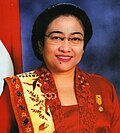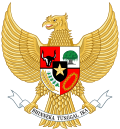Prezydenci Indonezji
Prezydent Republiki Indonezji – zgodnie z Konstytucją Republiki Indonezji najwyższy przedstawiciel indonezyjskich władz.
| IndonezjaTen artykuł jest częścią serii: Ustrój i polityka Indonezji Ustrój polityczny Konstytucja Władza ustawodawcza Władza wykonawcza Władza sądownicza Kontrola państwowa Finanse Samorząd terytorialny Partie polityczne Wybory Polityka zagraniczna Wikiprojekt Polityka |
| Osoba | Kadencja | Partia polityczna | |||
|---|---|---|---|---|---|
| # | Imię i nazwisko | Portret | Od | Do | |
| 1 | Sukarno (1901–1970) |  | 18 sierpnia 1945 | 12 marca 1967 | Bezpartyjny |
| 2 | Suharto (1921–2008) |  | 12 marca 1967 | 21 maja 1998 | Golkar |
| 3 | Jusuf Habibie (1936–2019) |  | 21 maja 1998 | 20 października 1999 | Golkar |
| 4 | Abdurrahman Wahid (1940–2009) |  | 20 października 1999 | 23 lipca 2001 | Narodowa Partia Przebudzenia |
| 5 | Megawati Sukarnoputri (1947– ) |  | 23 lipca 2001 | 20 października 2004 | Indonezyjska Partia Demokratyczna – Walka |
| 6 | Susilo Bambang Yudhoyono (1949– ) |  | 20 października 2004 | 20 października 2014 | Partia Demokratyczna |
| 7 | Joko Widodo (1961– ) |  | 20 października 2014 | nadal | Indonezyjska Partia Demokratyczna – Walka |
Bibliografia
Media użyte na tej stronie
Bacharuddin Jusuf Habibie official portrait.jpg
Bacharuddin Jusuf Habibie, 7th Vice President of Indonesia
Bacharuddin Jusuf Habibie, 7th Vice President of Indonesia
Joko Widodo 2014 official portrait.jpg
Joko Widodo official potrait, provided by the Government of Indonesia
Joko Widodo official potrait, provided by the Government of Indonesia
Susilo Bambang Yudhoyono, official presidential portrait (2004).jpg
Official presidential portrait of Susilo Bambang Yudhoyono (2004–2009)
Official presidential portrait of Susilo Bambang Yudhoyono (2004–2009)
National emblem of Indonesia Garuda Pancasila.svg
State emblem of Indonesia is called Garuda Pancasila. The main part of the coat of arms is the golden mythical bird Garuda with a shield on its chest and a scroll gripped by its leg bears the national motto: "Bhinneka Tunggal Ika", roughly means "Unity in Diversity". The shield's five emblems represent Pancasila, the five principles of Indonesia's national philosophy. The numbers of feathers was meant to symbolize the date of Indonesian Proclamation of Independence; 17 feathers on each wings, 8 tail feathers, 19 upper tail feathers (under the shield, above the tail), and 45 neck feathers; all symbolize 17-8-1945; 17th August 1945. Garuda Pancasila was designed by Sultan Hamid II of Pontianak, and was adopted as national coat of arms on February 11, 1950.
State emblem of Indonesia is called Garuda Pancasila. The main part of the coat of arms is the golden mythical bird Garuda with a shield on its chest and a scroll gripped by its leg bears the national motto: "Bhinneka Tunggal Ika", roughly means "Unity in Diversity". The shield's five emblems represent Pancasila, the five principles of Indonesia's national philosophy. The numbers of feathers was meant to symbolize the date of Indonesian Proclamation of Independence; 17 feathers on each wings, 8 tail feathers, 19 upper tail feathers (under the shield, above the tail), and 45 neck feathers; all symbolize 17-8-1945; 17th August 1945. Garuda Pancasila was designed by Sultan Hamid II of Pontianak, and was adopted as national coat of arms on February 11, 1950.
President Megawati Sukarnoputri - Indonesia.jpg
Megawati Soekarnoputri, fifth President of Indonesia
Megawati Soekarnoputri, fifth President of Indonesia
President Suharto, 1993.jpg
Suharto, second President of the Republic of Indonesia, at the start of his sixth term
Suharto, second President of the Republic of Indonesia, at the start of his sixth term
Presiden Sukarno.jpg
Official Portrait of President Sukarno.
Official Portrait of President Sukarno.








